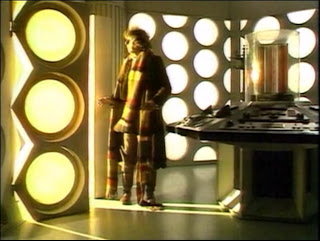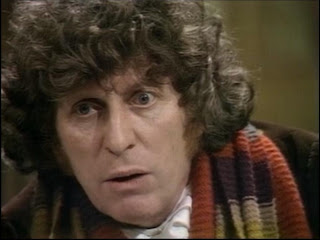The early Doctor Who stories were in the form of Serials – feature-lenth stories spread over several episodes. By the ‘70s, four 25-minute parts were generally found to be optimal: enough time for substantial character development and plotting, not (usually) enough time to get boring. Now, in his second season as producer, Graham Williams was eager to make a mark on the series besides “not as good as the last two guys,” and tried for a novel, ambitious idea: interlinking an entire season of serials into one massive, epic story. Of course, today, there’s nothing special about the notion, but it was pretty impressively original at the time.
The story: The Doctor is confronted by the White Guardian – a stunningly powerful being whose power dwarfs even that of the Time Lords. The Guardian sends him on a mission: gather the six pieces of the Key To Time, which will enable him to keep the universe from falling into chaos. The pieces have disguised themselves into all manor of objects, but will be given a way to find the objects and return them to their original state. He would be aided in this quest by a fellow Time Lord, Romana, and would be opposed by the unknown forces of the Black Guardian. It was an epic idea, and for a while, it played out very well. In the end, it never came to a satisfying conclusion, and the format wouldn’t be tried again for nearly a decade, but it certainly started with a bang.
For the first episode, The Ribos Operation, Williams turned to former script editor Robert Holmes. Holmes is rightly regarded as the best writer of Doctor Who’s classic era, having written or co-written among others Spearhead in Space, Carnival of Monsters, Pyramids of Mars, The Brain of Morbius, The Talons of Weng-Chiang, and The Caves of Androzani, and this lives up to his reputation.
The opening appearance of the White Guardian, however, was written by Williams and script editor Anthony Read, and it is itself an excellent opening. The TARDIS is taken off-course and its doors forced open with incredible ease, after which the Doctor walks out to the world he’s been brought to…
Which isn’t exactly expected. In fact, the quiet underplaying of the White Guardian visually and performance-wise contrasted with mind-boggling things he says rather casually:
Doctor: Ah! You want me to volunteer, is that it?
White Guardian: Precisely.
Doctor: And if I don’t?
White Guardian: Nothing.
Doctor: Nothing? You mean nothing will happen to me?
White Guardian: Nothing at all. Ever.
After that, we meet Romanadvoratrelunder, a name the Doctor shortens over protest to Romana.
Romana turns out to be one of the Doctor’s greatest companions, not least because, as a fellow Time Lord, she every bit as intelligent (or at least very nearly) as the Doctor himself. It’s a blast to watch her wittily deflate the Doctor like no one else could. Mary Tamm plays her with both great humor and regality, and her dialogue with the Doctor is one of the highlights of this story.
Romana: What would you like me to do?
Doctor: I’d like you to stay out of my way as much as possible. I don’t suppose you can make tea?
Romana: Tea?
Doctor: No, no, I don’t suppose you can. They don’t teach you anything useful at the academy, do they?
Romana: It’s funny, before I met you, I was even willing to be impressed.
Doctor: Indeed?
Romana: Oh, yes. Of course, now, I realize that your behavior comes from a sub transitory experiential hypertoid induced condition aggravated I expect by multi- and cathelogical tensions.
Doctor: … what’s that supposed to mean?
Romana: Well, to put it very simply, Doctor, you’re suffering from a massive confrontation syndrome.
Doctor: Is that the sort of rubbish they’re pouring into you at the academy?
Romana: You know, I might even use your case in my thesis when I get back.
Doctor: I’ll call you “Romana.”
Romana: I don’t like Romana.
Doctor: It’s either Romana or Fred.
Romana: All right, call me Fred.
Doctor: Good. Come on, Romana.
But in a Robert Holmes script, dialogue is a highlight throughout, no matter who’s talking. It’s a joy simply to listen to the people talking, regardless of plot. It’s also got Holmes’s trademark double acts – the Doctor & Romana, of course, but also Garron and Ustoffe, a truly hilarious pair of conmen, and Graff Vynda K and Sholakh as the villain and his second-in-command. Graff Vynda-K is a particularly noteworthy character. Even though he’s enjoyably evil, he’s superbly fleshed out and totally three-dimensional.
The Ribos Operation takes place on a world stuck in its own dark ages. Intergalactic conmen Garron and Ustoffe are attempting to sell it to Graff Vynda-K, an exiled tyrant of another planet. The planet should be worthless to the Graff, but Garron and Ustoffe are trying to convince him that it’s actually rich in Jethrik, the most valuable mineral in the galaxy, even though the only Jethrik on the planet is a large slab Garron and Ustoffe themselves brought there. Into this mix enter the Doctor and Romana, who realize the first piece of the Key is, in fact, the piece of Jethrik the two cons are carrying about.
This being a story of cons, things get bad quickly, and a vengeful Graff Vinda-K attempts to execute them all, assuming the Doctor and Romana are with the cons.
Graff Vinda-K: [to Garron] Get up, you cringing cur!
Doctor: Uh, yes, get up, you cringing cur!
Garron: Oh, just, ah, taking my friends for a little stroll.
Graff Vinda-K: Don’t lie to me! [moves to hit Garron]
Doctor: Don’t hurt the cringing cur!
It’s an engaging yarn, filled to the brim with double-crosses and witty exchanges, but the best part of the story is only barely connected to the plot, and that’s the character of Binro. Binro is an outcast on the world of Ribos for believing that Ribos orbits a star. His story adds a remarkable emotional power to the story, and through him Holmes fleshes out the world of Ribos more than all manor of technical wizardry ever could.
It’s a terrific, crackling script throughout. Holmes even knows how to use K-9 effectively. I like K-9, but he’s an exceedingly difficult character to use effectively. Holmes nails it, keeping him convincingly out of the action for the first two-thirds, and using him nicely in the last.
The only real flaws come from the production and one of the actors. Director George Spenton-Foster does a terrific job staging a dialogue-heavy story, giving it plenty of energy. The entire story is shot on rather small interior sets, but they’re excellent sets, if a bit tight. The costumes are spectacular. The only real issues are the monster who rear their rubbery head briefly. Both are pretty cheap, unimpressive monster. Fortunately, each of them only have a small part to play in the story, and Spenton-Foster minimizes their screen time.
Most of the performances are sterling. Unfortunately, the one occasional weak link is the Doctor himself, Tom Baker. Oh, he’s a great Doctor, when he’s good in Ribos Operation, he’s spectacular. But this was his fifth season as the Doctor, and in some of his later performances, he tended to overplay the comedy he loved so much, letting it bleed into scenes that required seriousness. This isn’t nearly as bad as it would get in the next season on a few occasions, but Tom’s shenanigans turn a couple of major dramatic scenes into a cartoonish slapstick routine. He’s ever so much funnier when he reads his funny lines seriously. Fortunately, only a few scenes suffer from his unfortunate tendancies; most of Ribos is blessed with Tom at his most magnificent.
The Ribos Operation is a strong start to an ambitious season, and furthermore, it’s an excellent stand alone story. Fantastic characterizations, brilliant dialogue, and an intriguing world, set in an exciting story that builds to a great climax. One of the classics.
RATING:
* * * ½
SIDENOTES:
· Cyril Luckham’s performance as the White Guardian really is wonderful. He underplays it beautifully, as though the Guardian isn’t really concerned with the universe plunging into chaos. It’s just another day on the job. It makes it much more convincing and mind-blowing than a more obviously “mystical” reading or more over-the-top portrayals (as future appearances of the Guardians proved). His reading of “Beware,” as though it’s slightly amusing to him, is a great exit.
· The difference between “Bad Tom” and “Good Tom” are actually pretty subtle in pictures, but unmistakable when watching. Nonetheless, I tried to capture it. First, Bad Tom, from the cliffhanger in episode 2, where his face actually ruins the Graff ordering his execution.
And now, Good Tom, from the scene where Garron tells him the background of Graff:
It’s really hard to show in a still, but Baker’s intensity add tremendously to the sequence. His face raises the scene from good exposition and background to gripping and powerful. That’s one of the reasons Season 12 felt so promising, even when it dropped to junk like Revenge of the Cybermen: it was an entire season of Good Tom, and Good Tom is magnificent.
And now, Good Tom, from the scene where Garron tells him the background of Graff:
It’s really hard to show in a still, but Baker’s intensity add tremendously to the sequence. His face raises the scene from good exposition and background to gripping and powerful. That’s one of the reasons Season 12 felt so promising, even when it dropped to junk like Revenge of the Cybermen: it was an entire season of Good Tom, and Good Tom is magnificent.













No comments:
Post a Comment